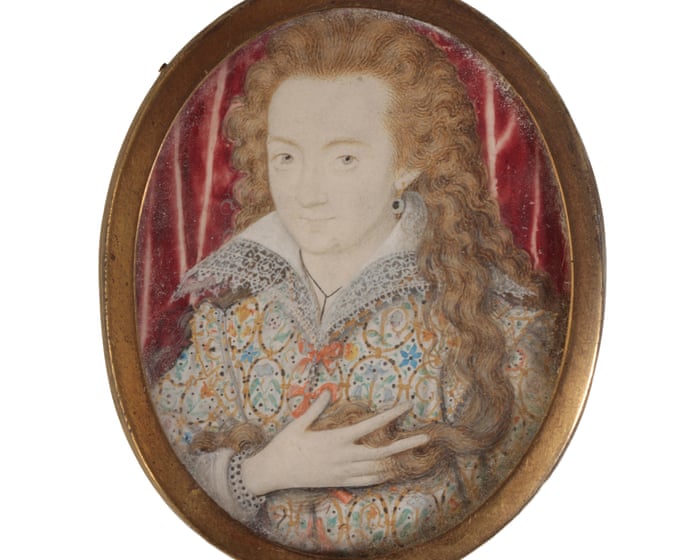The discovery of a previously unknown portrait miniature by one of Elizabethan England’s greatest artists would be remarkable on its own. But a newly identified work by Nicholas Hilliard is especially exciting because it may have a connection to William Shakespeare, and it bears a 400-year-old mystery: a defaced red heart on the back, hinting at a love scorned.
Hilliard was Queen Elizabeth I’s official miniature painter. His delicate, palm-sized portraits are among the most treasured masterpieces of 16th-century British and European art.
This portrait shows an androgynous, bejeweled young person with long curls, believed to be the earliest known image of Henry Wriothesley, the 3rd Earl of Southampton—Shakespeare’s friend and patron, and possibly the “fair youth” some speculate is the subject of the sonnets.
Shakespeare dedicated his two narrative poems, Venus and Adonis and The Rape of Lucrece, to Southampton, writing: “The love I dedicate to your lordship is without end.”
Such miniatures were painted on vellum as thin as onion skin, mounted on playing cards for support. The back of this portrait reveals a card whose red heart has been painted over with a black spear or spade, suggesting a broken heart.
The portrait was identified by leading art historians Dr. Elizabeth Goldring and Emma Rutherford, who were astonished by the defacement.
Goldring, an honorary reader at the University of Warwick and author of an award-winning Hilliard biography, told the Guardian: “You always hope there might be a clue on the back or hidden in the frame, but there almost never is. This time, there was—and it was absolutely thrilling. Shivers down the spine. Someone went to great effort to spoil the back of this work.”
Rutherford, founder of the Limner Company, a consultancy and dealership, said: “I’ve never seen evidence of this kind of vandalism before. Everyone knew miniatures were backed with playing cards, but the back was never visible. Originally, this would have been in an expensive, possibly jeweled locket. You’d have to remove it to vandalize the back like this. It’s an extraordinary discovery—a 400-year-old mystery.”
Their research, co-authored with leading Shakespeare scholar Prof. Sir Jonathan Bate, is published in the Times Literary Supplement on September 5.
They write: “The fact that the heart has been painted over with a spade or spear inevitably brings Shakespeare to mind. His coat of arms, designed around 1602, included a spear as a pun on his name—though we know very little for certain about Shakespeare’s interactions with Southampton.”
Goldring added: “This discovery will likely reignite debate about the relationship between Shakespeare and his patron, including whether Southampton inspired some of the sonnets.”
The historians suggest the portrait may have been a gift from Southampton to Shakespeare, who perhaps returned it—possibly in 1598, the year he married.
At the Elizabethan court, Southampton was known for his androgynous beauty, vanity, and love of poetry. In the 1590s, John Clapham dedicated his retelling of the Narcissus myth to him, and Thomas Nashe, in the dedication to The Unfortunate Traveller, praised Southampton as “a dear lover and cherisher… of the lovers of Poets.”As for the poets themselves.
Skip past newsletter promotion.
Sign up for Art Weekly, a free weekly newsletter that rounds up the biggest stories, scandals, and exhibitions in the art world.
Enter your email address to sign up.
Privacy Notice: Newsletters may include information about charities, online advertisements, and content funded by external parties. If you don’t have an account, we’ll create a guest account for you on theguardian.com to send the newsletter. You can complete full registration anytime. For details on how we use your data, see our Privacy Policy. We use Google reCaptcha to protect our website, and the Google Privacy Policy and Terms of Service apply.
After newsletter promotion:
Will at the center of a legal battle over Shakespeare’s home, unearthed after 150 years. Read more.
The portrait’s owners have a family connection to Southampton but were unaware of Hilliard’s involvement or the work’s significance, having stored it in a box for years. They reached out to Goldring and Rutherford after reading about their discovery of another Hilliard miniature.
Rutherford said, “This has never been published. It’s never been seen in public.”
They believe it depicts Southampton in the early 1590s, when he was in his late teens, just before Shakespeare gained his patronage.
Addressing the long-debated identity of the addressee in Shakespeare’s sonnets, they write: “Again and again, the sonnets return to the fair youth’s androgynous beauty. For example, in sonnet 99, his hair is compared to ‘marjoram,’ which has long, curly tendrils: could this refer to Southampton’s distinctive long ringlets?”
They argue that everything about this miniature, including the sitter’s gesture of holding his flowing auburn ringlets to his heart, suggests an intimate portrayal.
Long hair was unusual at the late Elizabethan court, Rutherford noted. “We know there was criticism that long hair made men look ‘womanish.’”
Two pearl bracelets adorn the sitter’s wrist. Rutherford pointed out that bracelets, though common in portraits of women from that time, were rarely seen in men’s portraits.
She added that when people first see the portrait, they often have trouble telling whether it’s a man or a woman. “It’s just extraordinary. It has to be one of the earliest English homoerotic images.”
Frequently Asked Questions
Of course Here is a list of FAQs about the newly discovered portrait potentially of Shakespeares fair youth written in a natural tone
General Beginner Questions
Q What is this fair youth portrait everyone is talking about
A Its a recently discovered centuriesold portrait that some experts believe depicts the young man to whom William Shakespeare dedicated his famous sonnets
Q Who is the fair youth in Shakespeares sonnets
A The fair youth is the unnamed young man who is the subject of Shakespeares first 126 sonnets The poems express deep admiration love and advice for him His real identity is one of literatures biggest mysteries
Q Why is finding this portrait such a big deal
A If authentic it would be the firstever potential face to put to this famous literary figure giving us a visual connection to Shakespeares most personal work
Q Where was this portrait found
A The details of its discovery are often part of the story but its typically found in a private collection an estate sale or within the archives of a historic house previously misidentified or overlooked
Advanced Detailed Questions
Q How do experts know its actually the fair youth and not just some random person
A They dont know for certain Experts use a combination of methods forensic art analysis historical records of who owned the portrait and comparing the subjects age and aristocratic clothing to the timeline and descriptions in the sonnets
Q What evidence is used to authenticate a portrait like this
A Key evidence includes
Dendrochronology Treering dating of the wooden panel its painted on
Pigment Analysis Identifying paints that were only available in a specific time period
Provenance Tracing the paintings ownership history back as far as possible
Stylistic Analysis Comparing the artists technique to other known works from the era
Q Who are the main candidates for the reallife fair youth
A The most popular historical candidates are
Henry Wriothesley 3rd Earl of Southampton A known patron of Shakespeare to whom he dedicated two poems




